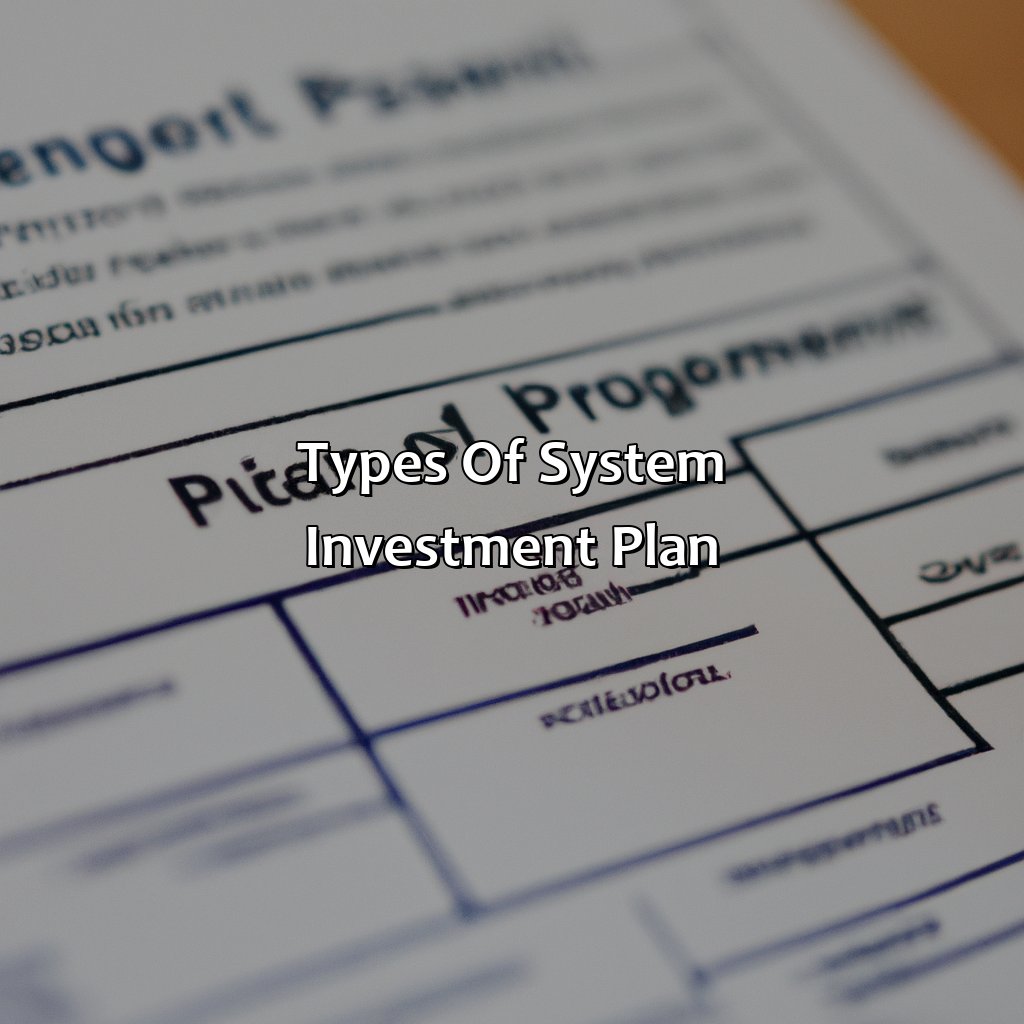What Is System Investment Plan?
Key Takeaway:
- A System Investment Plan (SIP) is an investment strategy that allows investors to make regular, automated investments in mutual funds or other investment vehicles, typically on a monthly basis.
- The purpose of a System Investment Plan is to provide a disciplined approach to investing, helping investors to avoid emotional, knee-jerk reactions to market fluctuations and to ensure consistency in their investment approach.
- The advantages of a System Investment Plan include consistency in investment approach, diversification across various mutual funds, and a long-term approach that can help investors achieve their financial goals.
Do you want to invest your money in a reliable and secure platform? System Investment Plan is designed to meet all your investment needs. This article will explain how SIP works and its benefits so that you can make an informed decision.
Understanding System Investment Plan
Understanding the Concept of Systematic Investment Plan (SIP)
A Systematic Investment Plan (SIP), commonly known as SIP, is a disciplined investment approach that allows individuals to invest small amounts of money regularly in mutual funds. SIPs can be customized to suit individual investment goals, risk appetite, and investment horizon. With SIP, investors can enjoy the benefit of compounding their returns over time, as their investment amount accumulates systematically.
Investing through SIPs can help investors achieve their long-term financial goals, such as saving for retirement, children’s education, or building wealth. SIPs promote financial discipline and encourage investors to stick to their investment plan even in volatile market situations.
Moreover, SIPs offer several advantages such as cost averaging, diversification, flexibility, and convenience. They help investors to avoid the risk of timing the market and minimize the impact of market volatility on their portfolio.
Investors can start with a small amount as low as INR 500 per month and gradually increase their investment amount based on their financial goals and income. SIPs allow investments in equity, debt or hybrid funds, depending on the risk appetite of the investor.
For instance, Mr. X started investing in SIPs ten years ago with a small amount of INR 1,000 per month. He continued his investments regularly and now has accumulated a significant corpus, which has helped him achieve his financial goals.
In summary, SIPs are an excellent investment strategy for individuals who seek long-term wealth creation, financial discipline, and a convenient investment approach. With the help of a professional financial advisor, investors can create a customized SIP portfolio that suits their investment goals, risk tolerance, and financial situation.

Image credits: retiregenz.com by Adam Duncun
Definition and Purpose of System Investment Plan
A System Investment Plan is a strategic planning tool that guides organizations to invest in technology, resources, and people. It ensures that the organization is aligned with the current and future needs of customers and stakeholders. The primary purpose is to identify and prioritize investments that will yield the greatest return on investment, provide the most significant benefit to stakeholders, and support the organization’s mission and vision. The plan is vital for organizations to make informed decisions, increase business performance, and remain competitive in the market.
The key objective of a System Investment Plan is to identify areas of improvement and align them with the organization’s mission and vision. It involves assessing the current technology landscape, identifying gaps and areas for improvement, and prioritizing investments based on business value. The plan helps organizations to optimize investments, reduce costs, and improve service quality for customers. Additionally, a good investment plan facilitates effective decision-making, improved governance, and risk management.
Furthermore, a successful System Investment Plan requires strong leadership, cross-functional collaboration, and stakeholder engagement. It should be reviewed and updated regularly to keep up with changes in the technology landscape and business context. This ensures that the plan remains relevant, adaptive and agile to meet the organization’s changing needs.
In a similar tone, a small business owner was looking to expand his operations but did not have a clear direction on how to do it. He engaged a consultant who helped him develop a System Investment Plan. The plan identified specific investments in technology, human resources, and marketing that would help the business grow and meet its objectives. The business owner was able to prioritize investments and allocate resources effectively, leading to significant growth in revenue and the number of employees.

Image credits: retiregenz.com by Harry Jones
Advantages of System Investment Plan
Let’s delve into the advantages of System Investment Plan (SIP). It provides consistency, diversification and a long-term approach. By following its sub-sections, you can optimize your investment portfolio. You can also reach your financial goals gradually.

Image credits: retiregenz.com by David Jones
Consistency
Investing consistently is a crucial factor in the overall success of a Systematic Investment Plan. Consistence helps manage risk, minimize market fluctuations and prove beneficial over time. A steady investment plan can ride out any ups and downs in the market, yielding profitable results.
The key to consistent investing is to have a well-thought-out strategy that aligns with your objectives. One can diversify their portfolio to mitigate risk, opt for automation to reduce errors and lock-in life goals to stay focused.
Consistency also helps build habits over time, anchoring investment as a part of regular financial planning. Investing regularly and keeping an eye on progress generates compounding interest, which proves beneficial over a long period.
A systematic approach towards investing offers a stress-free way of reaching your financial goals. It promotes patience and discipline while exploring different investment options that work best for you.
Pro Tip: Being consistent doesn’t mean you cannot adapt or improve along the way. Set realistic goals, track performance and be open to adjustments as per your financial situation.
Putting all your eggs in one basket may be tempting, but diversification is the smart way to invest and avoid ending up with an omelette.
Diversification
Investing in a Systematic Investment Plan is an effective way of achieving diversification in your investment portfolio. Diversification refers to the practice of investing in different asset classes, such as equity, debt, and commodities. This can help reduce the overall risk of your investment portfolio by spreading your money across various categories.
Diversification also includes investing in different companies within the same sector and geographical areas which lowers exposure to any one company or market. SIPs allow you to invest regularly and benefit from cost averaging and automatic portfolio rebalancing. These benefits promote diversification by allowing you to invest in various mutual funds with similar objectives.
By diversifying through SIPs, you can benefit from long-term returns despite short-term market fluctuations while mitigating risks. This form of investment offers a range of plans with fund combinations adjusted for varying degrees of risk tolerance ensuring maximum profitability no matter how much the investor wants to invest.
When discussing diversified investments it’s essential to consider an array of sectors that are worth investing in. The aim here is to cater to long-term planning issues that investors might face when thinking about retirement planning or education funding for their children, or otherwise face losing out on future wealth growth.
Planning for the long-term is like investing in a good pair of sneakers – it may not be flashy, but it’ll save you from blisters in the future.
Long-Term Approach
Taking a sustained approach to investing is essential for long-term growth and financial stability. Investing in the System Investment Plan provides outstanding benefits in terms of consistent returns year-on-year, safeguarding against market volatility, and ensuring future prosperity without relying solely on active income streams. This systematic investment approach encourages investors to think about their long-term goals rather than making aggressive decisions based on the short-term performance of particular assets.
A System Investment Plan follows an algorithmic approach that invests regularly over a chosen period. Picking up units quickly at lower prices, which can be capitalized when the markets rebound to earn significant returns. Diversification of risk through easy access to equity markets allows for controlled exposure with less need for constant monitoring and modifying of portfolio assets.
Investing in this way was initially the domain of big institutional investors, who had the resources and analytical know-how to benefit from it. Over time, advances in technology have made it possible for regular investors to access these methods using small amounts with equal ease and comfort.
With this strategy, understanding what is happening in financial portfolios is crucial. Therefore investors must stay updated on portfolio developments as they embrace asset allocation using stock or bond funds according to their investment goal.
An early example of a person who succeeded phenomenally over time with Systematic Investments was Warren Buffet. The Oracle of Omaha consistently advised people who want to build wealth over time by investing regularly for high returns by being disciplined, not reactionary, having a clear-cut plan reinforced with his systematic buying approach that concentrated on fundamentally solid companies rather than speculation.
Get ready to choose wisely, the different types of system investment plans are like a box of chocolates, you never know what you’re gonna get.
Types of System Investment Plan
Ready to learn about the types of system investment plans? This section’s all about it! Focus on solutions like SIP, STP, and SWP. Each one has its own advantages. So, it’s essential to know what they offer before deciding which plan is right for you.

Image credits: retiregenz.com by Joel Duncun
SIP – Systematic Investment Plan
A systematic investment plan, commonly known as SIP, is a type of investment strategy that allows individuals to invest small amounts at regular intervals. This method helps in reducing the risk of investing a large amount at once and helps in accumulating wealth over time.
SIP works by investing a fixed amount at regular intervals over an extended period. This investment plan is popular among individual investors who want to create a long-term corpus for their financial goals like retirement planning, children’s education, etc. The frequency of investment can range from weekly to monthly or quarterly.
One unique aspect of SIP is that it allows investors to invest in mutual funds with as little as Rs 500 per month. This flexibility makes it easy for even small investors to start investing without compromising on their other financial commitments.
Investors should begin their SIP with a clear understanding of their financial goals and risk appetite. They must also select the right mutual fund scheme based on their investment goals and expectations. Diversifying investments across different mutual fund schemes can help spread risks and stabilize returns.
STP – the lazy investor’s way of automating their transfers and avoiding the guilt of forgetting to invest regularly.
STP – Systematic Transfer Plan
Systematic Transfer Plan (STP) is a type of investment plan that enables investors to transfer funds systematically from one scheme to another. A fixed amount can be transferred periodically from one investment plan to another, helping investors to manage their investments effectively.
STP plans are beneficial in mitigating the risk involved in investing all at once or making a lump-sum investment. This helps investors average out the purchase price of their investments and make the most of market volatility.
In addition, STP plans come with an added advantage of flexibility, as they can be customized as per the investor’s requirements. Investors who are looking for an opportunity to diversify their portfolio can choose investments in different types of assets based on market trends.
In the past few years, STP has emerged as one of the most popular types of investment plans due to its ease of use and benefits. With the added benefit of automated transactions through mutual fund portals, it has never been easier for investors to switch between schemes and manage their investments efficiently.
If you can’t handle a systematic withdrawal plan, just withdraw systematically from reading this article.
SWP – Systematic Withdrawal Plan
Systematic Withdrawal Plan or SWP is a type of System Investment Plan that allows investors to withdraw a fixed amount of money regularly from their investments. The plan is useful for retirees who want to receive monthly or quarterly income from their investments without compromising the principal amount.
Investors can choose the withdrawal amount as per their requirements and risk tolerance. The withdrawal frequency may vary based on the investment scheme, and it can be weekly, monthly, quarterly or annually. Moreover, investors can choose whether they want to withdraw a fixed amount or variable one based on the market conditions.
Unique details about SWP include its flexibility in terms of investment horizon and payout period. The plan provides stability and regular cash flow, which means that investors need not depend on market performance for income generation. Moreover, it is tax-efficient as the gains from long-term capital appreciation are taxed at a lower rate than short-term capital appreciation.
In history, many prominent mutual fund houses such as SBI Mutual Fund, HDFC Mutual Fund and ICICI Prudential have offered SWP schemes to retail investors since its inception in 2013. The popularity of SWP has increased recently due to its usefulness in generating a regular income stream post-retirement without touching the principal invested amount.
Investing in a system investment plan is like learning a new language – it may seem daunting at first, but with a little practice and dedication, anyone can become fluent in the language of finance.
How to Start Investing in System Investment Plan
To begin investing in the System Investment Plan, there are sub-sections to consider. Firstly, choosing a mutual fund. Secondly, selecting an amount. Lastly, setting up a SIP. It’s essential to have a disciplined and organized approach. Each of these steps is vital for successful investing in SIPs. Let’s delve deeper to comprehend the procedure of investing with an SIP.

Image credits: retiregenz.com by Harry Jones
Choose a Mutual Fund
When considering investment options, it’s important to select a suitable mutual fund. Understanding the various types available can help in making an informed decision.
- Identify your investment goals. Choose a fund that aligns with these goals.
- Consider risk tolerance. Low-risk funds offer lower returns but are less volatile, while high-risk funds can yield higher returns but come with more uncertainty.
- Research fees and expenses associated with the fund. This can impact the ultimate return on investment.
It’s crucial to note that each mutual fund has its unique characteristics and risks. As such, before investing in any mutual fund or choosing to reinvest in an existing one, make sure to read the prospectus and understand all relevant information.
Pro Tip: A diversified portfolio across multiple mutual funds can help spread risks and maximize investment potential.
Choosing how much to invest is like deciding how much candy to buy at the store – you want enough to satisfy your cravings, but not so much that you feel sick afterwards.
Select an Amount
To Begin Your System Investment Plan
When starting a system investment plan, consider the initial investment amount. Here are five points to assist you in selecting an investment amount, which can help you form a solid foundation for your investment journey:
- Assess the funds available: Before determining the sum of investment, analyse personal capital flow and ascertain how much money you have in hand for investing.
- Determine your financial goals: Identifying long-term and short-term financial objectives that will impact the amount invested and make meaningful progress towards realising those goals.
- Research market trends: Keep an eye on market trends so that you stay informed about when stock prices rise or dip and how they impact how much of an investment is necessary to obtain reasonable returns on investments made.
- Consider the risk tolerance level: While planning an investment strategy, select investment amounts only after evaluating your risk tolerance so that it aligns with the level of portfolio risk assumed for potential returns.
- Consult with Financial Advisors: Seek guidance from well-known financial advisors who possess expertise in analysing market activities and offering keen insights into developing optimal investment plans suited to your individual needs.
It’s important to note that despite having an idea of the appropriate sum to invest based on financial strategy analysis, there may still be some variance involved. As your portfolio grows over time and your financial circumstances change, modifications must be made.
Suggested Tips:
- You may begin investing in small increments when beginning a system investing plan if figuring out what amount is comfortable for you to start with seems overwhelming at first.
- Alternatively, do thorough market research before making any significant investments instead of making impulsive decisions intending large sums.
These suggestions work because reducing initial commitments lessens the possibility of experiencing substantial losses due to unforeseen occurrences within this largely variable field while providing more freedom & opportunity to adjust one’s portfolio with changing circumstances. Additionally, conducting thorough market research before making investments leads to better financial judgments and informed decision-making irrespective of the current market conditions.
Start sipping on your financial success with SIP; it’s a smooth and steady way to build your wealth.
Set up a SIP
When initiating an investment in a Systematic Investment Plan, investors have the opportunity to automate their investments and earn returns. Here is how to set up your SIP in five simple steps:
- Create a Mutual Fund Account with a reputable bank or financial institution.
- Select the mutual fund that best suits your investment goals.
- Set up an auto-debit instruction from your bank account for recurring investments.
- Define the frequency and amount of debit as per your preferences.
- Begin investing regularly and monitor performance periodically.
Investing in a Systematic Investment Plan has many advantages, including automated savings, rupee-cost averaging, flexibility to change investment amounts, easy exit strategies, potentially higher returns, and so on.
Lastly, consider setting realistic short- and long-term goals before entering into any investment plan. Additionally, study past performance of mutual funds, diversify across industries to mitigate risk exposure, and conduct due diligence on potential frauds or scams.
Some Facts About System Investment Plan:
A system investment plan is a long-term investment strategy that involves consistent contributions to a diversified portfolio. (Source: The Balance)
The goal of a system investment plan is to accumulate wealth over time and achieve long-term financial stability. (Source: Investopedia)
System investment plans often involve automatic contributions from a person’s salary or other income source. (Source: Fidelity)
A system investment plan should be tailored to an individual’s specific financial goals and risk tolerance. (Source: Forbes)
Some common types of accounts used in system investment plans include 401(k)s, IRAs, and mutual funds. (Source: NerdWallet)
FAQs about What Is System Investment Plan?
What is a System Investment Plan?
A System Investment Plan is an investment strategy that aims to maximize returns while minimizing risks by incorporating various plans, tools, and techniques.
How does a System Investment Plan work?
A System Investment Plan works by analyzing data to determine the best investment plan suitable to an individual’s financial goals and situation. It considers various factors such as age, financial status, risk tolerance, and investment objectives to create an optimal portfolio mix.
What are the benefits of a System Investment Plan?
The benefits of a System Investment Plan include minimizing risks by diversifying investments, maximizing returns by taking advantage of market trends, promoting discipline in following a consistent investment strategy, and providing a clear understanding of the investment portfolio.
How can I start a System Investment Plan?
You can start a System Investment Plan by first determining your goals, financial situation, risk tolerance, and investment horizon. You can then identify a reputable financial advisor who can help you create a personalized investment plan that suits your needs and preferences.
What are some popular System Investment Plans?
Some popular System Investment Plans include the 60/40 portfolio, the All-Weather Portfolio, the Couch Potato Portfolio, and the Permanent Portfolio. Each of these plans has its unique characteristics and risk-reward profiles that cater to different investment objectives and goals.
Is a System Investment Plan suitable for everyone?
A System Investment Plan may not be suitable for everyone. It is best suited for investors who are willing to take calculated risks, have a long-term investment horizon, and are looking to build and grow their wealth gradually over time. It is always advisable to seek professional financial advice before embarking on any investment strategy.
 Checkout this IRS Loophole
Checkout this IRS Loophole 
